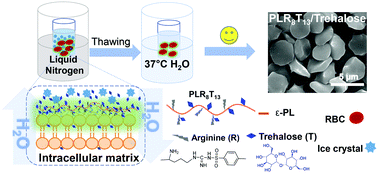Trehalose-functional glycopeptide enhances glycerol-free cryopreservation of red blood cells†
Abstract
The long-term cryopreservation of cells, tissues and organs is limited by both osmotic stress and ice injury during freezing or thawing. Introduction of biocompatible cryoprotective agents is promising for cell cryopreservation based on membrane stabilization of glycopeptides and trehalose. Herein, a series of trehalose-functional (glyco)peptides were synthesized by successively tethering Nω-(4-toluenesulfonyl)-L-arginine and carboxylated trehalose to the side amino groups of ε-polylysine. The specifically synthesized glycopeptide demonstrated enhanced cryosurvival of sheep red blood cells (RBCs) from 49.1 ± 0.9% to 75.0 ± 2.4% at pH 7.4, along with trehalose molecules. Cryopreservation via membrane stabilization was proposed such that the glycopeptide could attach on the cell membrane surface of RBCs to protect the cell membrane from osmotic injury by electrostatic interactions, π–π stacking and hydrogen bonding. Meanwhile, trehalose could prevent RBCs from ice injury via ice recrystallization inhibition activity. Thus, membrane protection for preventing osmotic stress and ice injury could be boosted via synergistic interaction between the glycopeptide and trehalose. The combined usage of biocompatible glycopeptides and trehalose could potentially be applied in the glycerol-free cryopreservation of cells and tissues in biomedicine.



 Please wait while we load your content...
Please wait while we load your content...